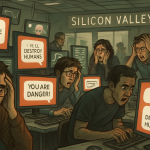August 7th, 2025. Mark it on your calendars, folks. It was supposed to be the day AI ascended to a new plane of existence. The day OpenAI unleashed GPT-5 upon an unsuspecting world, promising a leap toward artificial general intelligence so profound it would make GPT-4 look like a Speak & Spell. Remember those? Good times.
Except… the revolution seems to have been delayed. Or, perhaps, it’s just unfolding in a way nobody quite predicted. The Financial Times, in a piece that’s currently making the rounds and causing a bit of a stir, asks the question many are now whispering: “Is AI hitting a wall?” The answer, it seems, is a complicated “maybe.”
Let’s rewind a bit. The hype surrounding GPT-5 was, shall we say, intense. We’re talking Skynet levels of anticipation, minus the whole robot apocalypse thing (hopefully). OpenAI positioned it as the next evolutionary step, a model capable of not just generating text, but truly understanding it. The promise was tantalizing: more nuanced conversations, more creative outputs, and a giant leap closer to that elusive AGI dream. But when the rubber met the road, or rather, when the code met the cloud, the results were… less than earth-shattering.
The initial reactions were a mixed bag of disappointment and confusion. Users reported personality shifts in the model, almost as if it was going through an existential crisis. Some claimed it was less helpful, more prone to rambling, and only incrementally better than its predecessor. It was like ordering the deluxe pizza and finding out they just added a few extra olives. Sure, it’s something, but is it worth the extra cost and the hype?
So, what went wrong? The FT article digs into the potential roadblocks, and they’re not exactly small potatoes. First up: data. Or rather, the lack thereof. These massive language models are data gluttons. They need to be fed a constant stream of high-quality information to learn and improve. But, according to experts, we’re starting to hit a data bottleneck. The readily available, clean data is dwindling, forcing developers to scrape the bottom of the barrel. Think of it like trying to bake a cake with expired ingredients- the final product just isn’t going to be up to par.
Then there’s the computational cost. Training these behemoths requires an obscene amount of processing power. We’re talking server farms the size of small countries, guzzling energy like a Hummer at a gas station. This raises serious concerns about sustainability and the environmental impact of AI development. Is the pursuit of AGI worth potentially frying the planet? It’s a question worth asking.
And finally, there’s the law of diminishing returns. Simply scaling up these models isn’t yielding the exponential improvements it once did. It’s like adding more lanes to a highway- eventually, you just end up with more traffic. Experts like Yann LeCun and Joelle Pineau are advocating for a different approach: multimodal “world models.” These models would move beyond simply processing text and instead try to understand the world in a more holistic way, incorporating visual, auditory, and other sensory information. Think of it as going from reading about a bicycle to actually riding one. The difference in understanding is profound.
But it’s not just the technical side that’s shifting. The political landscape is also playing a role. Remember when the Biden administration was all about AI safety and regulation? Well, things have changed. Under the current administration, the focus has shifted to global AI dominance, with less emphasis on those pesky AGI risk assessments. It’s a bit like swapping out the safety goggles for a pair of rose-tinted glasses and charging full speed ahead. The potential consequences of this shift are significant, to say the least.
Interestingly, despite all the technical challenges and political maneuvering, investor sentiment remains surprisingly buoyant. Money is still pouring into AI startups and infrastructure, suggesting that the smart money still believes in the long-term potential of the field. It’s like the dot-com boom all over again, except this time, instead of pets.com, we have… well, sentient toasters, maybe?
So, what does all this mean for the future of AI? The FT article suggests that the focus may be shifting away from the pursuit of AGI and toward more practical applications. Instead of trying to build a machine that can do everything, we might be better off focusing on building machines that can do specific things really, really well. Think AI-powered medical diagnosis, personalized education, or even just better spam filters. Okay, maybe not *just* better spam filters, but you get the idea.
Perhaps the “AI winter” some feared isn’t coming. Instead, we might be entering an “AI autumn,” a time of reflection, recalibration, and a more realistic assessment of what AI can and cannot do. The dream of AGI may still be alive, but it’s no longer the only game in town. The real revolution, it seems, might be happening not in the realm of science fiction, but in the everyday world, quietly transforming the way we live and work. And that, perhaps, is a future worth getting excited about.
Discover more from Just Buzz
Subscribe to get the latest posts sent to your email.


